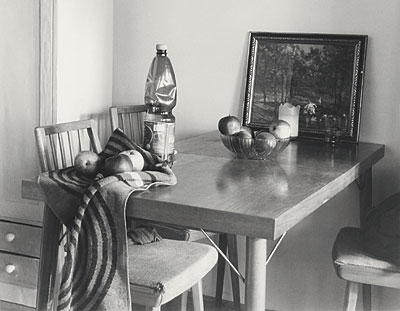| Revista Umělec 2004/2 >> Intelligent photography | Lista de todas las ediciones | ||||||||||||
|
|||||||||||||
Intelligent photographyRevista Umělec 2004/201.02.2004 Pavel Vančát | en cs |
|||||||||||||
|
The photographs of Michal Kalhous (1967), graduate in mathematics and physics and student of art history, bear distinctive features. Since the mid 90s he has had solo shows and also participated in important Prague group exhibitions (Zkušební provoz, and Snížený rozpočet at Mánes Art Gallery, 1995, 1997). In his early arranged still lives (introduced in 1997 in Velryba Art Gallery, Prague), Kalhous radically reduced the depth of field, and gradually moved towards more transparent visions containing more and more visible reflections of reality. It seems that for the last couple of years Kalhous has been sharpening his focus to make the images really special.
By coincidence, this spring Michal Kalhous has presented his works in three one-man shows in the Czech Republic — in Ústí nad Labem, České Budějovice and Ostrava. All of them proved his works to have varied systems of traits, and the final works to correspond considerably with the concrete realities of the actual exhibition space. In his shows at Ústí and Budějovice, he exhibited about twenty works, examining (non)photogenic simple things and acts. Yet at the Fiducia Art Gallery, Ostrava, he exhibited only three photographs of a somewhat suspicious gray shade that complemented the foundation stone of the Ostrava Kunsthalle (Kalhous likes provocative presentations as a by- product of his art). Regarding any strict photographic canon, Michal Kalhous actually often returns to the “new eternity” of the 1930s, with its passion of capturing very minor components of reality in photography. But there is an obvious difference. His photographs are black and white and of large size, adjusted to the actual show spaces. This. Here. And on the photograph. Photography has endured over a century, and with such intensive experience, contemporary photography gives meaning to “simple observing.” Also, distinct from art photography between the wars, Kalhous is not looking towards the future, but he looks back, determined to seek purity in monuments of photography. Most of Kalhous’ works anatomize nature, being like documents of domestic research of non-living (even dead) objects. One day there is just a chocolate figure or a plastic cup, and the next day only a bird or a banana skin. These installations are partially works of science, and partially works of home design, bearing a disarmingly honest simplicity (hereby we have to remember Ján Mančuška). In seemingly banal views of forest scenery, Michal Kalhous is occupied by true photographic visions of natural and domestic details reflecting in themselves an aspiration to representation. His work might remind us of the humor and detached views of Jasanský, Polák and the tender melancholy of Marketa Othová, but Kalhous introduces more gusto and obstinacy. Kalhous is intimately involved with his subjects so he is able to examine them with unusual closeness, free of initial admiration. In such conditions, the positions he approaches can be extremely marginal. The blurred photograph of a Socialist water fountain and the gray background with inconsistent studies of an armchair or a square placed inside the edge of a sofa, are markers of freedom in the photography of unknown liberty, of playfulness, bridged with honesty and intelligence. He tries to clean photography as he does a world vision. A considerable task indeed!
01.02.2004
Artículos recomendados
|
|||||||||||||









Comentarios
Actualmente no hay comentariosAgregar nuevo comentario